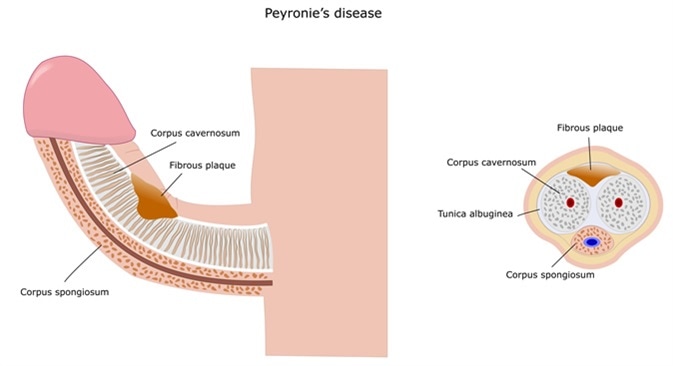The penis is the male organ used for urinary elimination and copulation, the latter being possible by its erectile ability. Its location is on the midline of the lower abdomen, at the level of the pubic bone (just above the scrotum). We can distinguish three main constituents of the penis: the crural (root), the body (mobile portion) and the glans (distal enlarged end).
Of all penile diseases, Peyronie’s disease represents one with often devastating physical and psychological consequences on affected individuals. Also known as induratio penis plastica, this is an incurable, fibrotic (scarring) disease that results in penile curvature, erectile dysfunction and subsequent coital failure.
Adequate treatment recommendations should be individualized according to the patient’s expectations, physical findings, disease history, and erectile function. However, the insights on the pathophysiology of this scarring issue are insufficient, resulting in a plethora of treatment options with questionable efficacy.

Peyronie's disease, with formation of a fibrous plaque and penis deviation. Image Credit: Ellepigrafica / Shutterstock
Historical Overview
The incipient description of the disease was penned in the 18th century by François Gigot de la Peyronie, who was a French surgeon to King Louis XV. As Peyornie himself had this disease, it is of no wonder he dedicated his life to study this disorder. Nevertheless, historians have found several written reports prior to Peyronie’s groundbreaking publication, which can be dated back all to way to 13th century and the work of Theoderic Borgogni from Bologna.
First suggested treatment by Peyornie was bathing in the holy waters of thermal spas at Barèges, which was followed by oral or topical used of agents (and their combinations) such as mercury and mineral water, bromides and hyperthermia, potassium iodide, copper sulfate, estrogens, arsenic, fibrinolysin, as well as disodium phosphate for acidification.
But despite its long history, the specificities of Peyronie’s disease etiology and natural history are still elusive. This is the reason why some researchers believe that theories and treatment options from the past may get modified and (re)introduced to the modern clinical practice.
"What causes Peyronie's Disease?" - Dr. Chris Love: Urological Surgeon
Disease Epidemiology and Significance
The prevalence of Peyronie’s disease in general population can be quite variable between studies. Generally accepted range in the literature is from 0.39% (population of Rochester, Minnesota) to 3.2% (Cologne, France). One large survey on 11,420 individuals from the US estimated its prevalence from 0.5 to 13.1%, explaining the variability with the differences in diagnostic criteria.
The disease epidemiology has also been researched in different sub-populations. In a cohort of men that underwent screening for prostate cancer, Peyronie’s disease prevalence was 8.9%. Significantly higher prevalence of 15.9% is seen in men after radical prostatectomy. Furthermore, in men evaluated for erectile dysfunction, Peyronie’s disease was found in 7.9% of affected individuals. Diabetes has also been identified as a potential risk factor for the development of this condition.
The burden of psychosocial distress that follows this condition is not negligible, as shown by studies using validated questionnaires. Certain emotional difficulties have been reported in 81% of men with Peyronie’s disease, while true depression may develop in up to 48% of affected individuals. Therefore, multidisciplinary approach should always be used when addressing this condition.
Further Reading